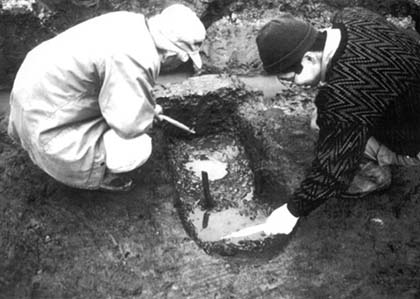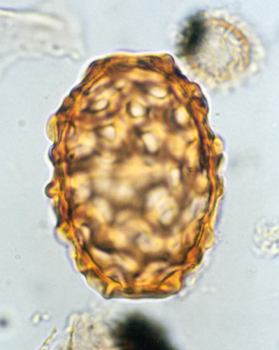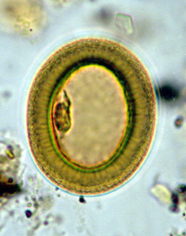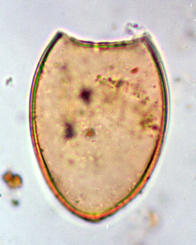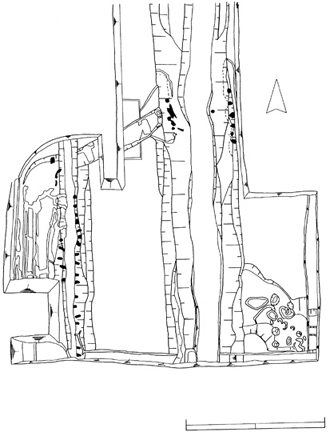Abstract
The development of palaeoparasitology in Japan has occurred in recent decades. Despite the fact that archaeology in Japan has been slow to develop techniques for excavating ancient toilets, important information about the development of sanitation has been derived from the analysis of a few sites. This shows that the earliest people had very simple methods of sanitation. As populations increased, sanitation became more complex. Ditches surrounding early towns were used for excrement disposal. Eventually distinct toilets were developed followed by cesspit type toilets and flushing toilets. The parasites recovered from these toilets include many species that infect humans today. These parasite spectra reflect local use of aquatic, marine, and land animals. Fecal borne disease was an increasing problem as represented by whipworm and ascarid roundworm eggs. Interestingly, ascarid roundworms were absent in the earliest cultures and only became common with rice agriculture. Finds of pollen and seeds in toilet sediments reveal the use of medicinal plants to control the emerging problem of parasites.
palaeoparasitology; sanitation; archaeology; Japan
Palaeoparasitology in Japan - Discovery of toilet features
Akira MatsuiI; Masaaki KaneharaII; Masako KaneharaIII
IPaleoenvironmental Laboratory, Nara National Cultural Properties Research Institute, 2-9-1, Nijo-cho, Nara 630-8577, Japan
IIArchaeological Science, Nara University of Education, Nara, Japan
IIITenri Branch, Paleoenvironmental Laboratories Inc., Tenri, Japan
Address to correspondence Address to correspondence Akira Matsui Fax: +81-(0)742-30-6856. E-mail: makira@nabunken.go.jp or makira@kcn.ne.jp
ABSTRACT
The development of palaeoparasitology in Japan has occurred in recent decades. Despite the fact that archaeology in Japan has been slow to develop techniques for excavating ancient toilets, important information about the development of sanitation has been derived from the analysis of a few sites. This shows that the earliest people had very simple methods of sanitation. As populations increased, sanitation became more complex. Ditches surrounding early towns were used for excrement disposal. Eventually distinct toilets were developed followed by cesspit type toilets and flushing toilets. The parasites recovered from these toilets include many species that infect humans today. These parasite spectra reflect local use of aquatic, marine, and land animals. Fecal borne disease was an increasing problem as represented by whipworm and ascarid roundworm eggs. Interestingly, ascarid roundworms were absent in the earliest cultures and only became common with rice agriculture. Finds of pollen and seeds in toilet sediments reveal the use of medicinal plants to control the emerging problem of parasites.
Keywords: palaeoparasitology - sanitation - archaeology - Japan
HISTORY OF PALEOPARASITOLOGY IN JAPAN
In Japan, palaeoparasitology research has been limited almost entirely to investigations of toilet sediments and coprolites (Fig. 1). The first detection of the parasite eggs in the Japanese archaeology began with the analysis of a cesspit, which was found during the excavation of the Fujiwara Palace Site at Kashihara City of Nara Prefecture (Fig. 2), which was the capital of Japan from 694 till 710 AD (Table). The excavation was done by the Nara National Cultural Properties Research Institute (Nabunken) in 1992 (Kurosaki 1992). This research was triggered by the visit of Akira Matsui to the York Environmental Archaeology Unit of the York University during his stay at the British Natural History Museum as a visiting scholar in 1989. At York, Matsui learned of the method of the identification of the toilet features in archaeological context and pertinent techniques of parasite detection from Andrew Jones who was the chief environmental archaeologist. After coming back to Japan, Matsui tried to locate and obtain soil from possible toilet features in Japan. However, he was met with the fact that Japanese archaeology at that time had not even managed to ascertain whether toilet features existed or not among many excavations. Currently in Japan, more than 10,000 excavations are made every year. Furthermore, almost 5,000 sites are presented in site reports year by year. Yet, despite the fact that this level of activity has now been going on for many years, it is quite strange that there is very little information pertaining to excretion. However, it was at around this time that Matsui was notified that a toilet-like pit had been found at one of the locations in the Fujiwara Palace Site (Fig. 3). With the excavation organization, by Nabunken, Matsui proceeded to collect all the sediment of the pit using the flotation which yielded small ecofacts like insects, seeds, animal bones etc. Matsui then identified these finds with the cooperation of experts from various fields.
Matsui also asked Masaaki Kanehara to analyze the pollen and his wife, Masako Kanehara, to check for parasite eggs. Masako was a technician of a hospital and after her success with parasite eggs from archaeological context, she setup the Tenri Branch of the Paleoenvironment Research Inc. The first parasites (Fig. 5) to be successfully identified were roundworms (Ascaris lumbricoides) (Fig. 6), whipworms (Trichuris trichiura) (Fig. 7), Yokogawa flukes (Metagonimus yokogawai) (Fig. 8), liver flukes (Clonorchis sinensis) (Fig. 9) and the beef or pork tepeworms (Taenia spp.) (Fig. 10) in small numbers. Yokogawa flukes indicates that people ate Ayu fish (Plecoglossus altivelis) that is popular catadromous fish in Japan and usually caught in summer. The lack of marine parasites indicates that this parasite combination is typical of areas like the Nara Basin that are far from the sea.
Fig. 4: quantitative diversity of the parasite eggs at Fujiwara Toilet
Subsequently, pork and beef tapeworm eggs (usually taken as indications of a diet incorporating meat) were identified in some quantity at the cesspits of Koro-Kan, the 8th century guesthouse in Dazaifu, Fukuoka City (1993). It was thought that these eggs were not from Japanese, who at that time had limited opportunity to eat meat, but rather were deposited by delegates from China and Korea (The Board of Education, Fukuoka City 1993). Another reason we believe that these eggs were deposited by foreigners is that there are no other such sites which yielded these eggs at that time period.
The cesspit toilets were found at the Yanagi-no-gosho Site in Hiraizumi Town (1995), Iwate Prefecture, a local Samurai and merchant town in Northeast Japan during 12th century [(Iwate Prefectural Archaeological Center) (Iwate Prefectural Archaeological Center)(Iwate-ken Maizo-Bunkazai Center )1995 ]. The findings there were characterized many eggs of a fish tapeworm (Diphyllobothrium sp.) (Fig. 10). This tapeworm infection is caused by eating raw or incomplete cooking of the anadoromous cherry salmon (Oncho) that run in early summer. The Kitakami River nearby is famous as a place where cherry salmon run even now.
A flushing toilet structure was found at Akita Castle (Figs 11, 12), the fortified offices of the central government of 8th to 9th century Japan located in the Tohoku area that includes Yanagi-no-gosho mentioned above. There, however, no fish tapeworm (Diphyllobothrium sp.) was found. Rather results indicated the presence of liver flukes and other parasites which tend to infect intermediate hosts such as cyprinids (i.e. carp). This may indicate that the toilet of Akita Castle was used not by people born and bred in Tohoku Area but rather by people posted or visiting from the central government of Nara or Kyoto, or by foreign delegates from Bo Hai Coast or others. Subsequent findings of toilet remains have been few, but the number of different types of parasite eggs identified are increasing little by little.
CHANGES IN TOILET FEATURES
Paleolithic Age to Jomon Period: Disposal of Excrement by Natural Dissolution
It is thought that Paleolithic people were basically migratory, never staying in one place for a long time. In contrast, the remains of the dwellings of many settlements in the later Jomon Period form a horseshoe-shaped configuration, of which the center part was a plaza and where shell middens and garbage yards were formed outside the dwellings. This indicates an increasing tendency to sedentary settlement at that time. Actual fecal remains, known as coprolites, were found in the shell middens belonging to the Jomon Period. The coprolites were formed when the first the Jomon people or their housedogs defecated onto a shell midden.The excrement was subsequently covered by discarded shells. The coprolites naturally adhered to the shells in such a way as to maintain the original shapes of the excretions. Calcium seeped out of the shells and permeated the coprolites. As a result, the coprolites hardened to become stone-like. Because of this calcified condition, it was impossible to soften them by using trisodium phosphate. The late Michiko Chiura of the International Christian University, who once studied in Canada, endeavored to further our knowledge through studies of coprolites from the Torihama shell midden in Fukui Prefecture in 1970's. Regrettably the high hopes that accorded her as a pioneer of Japanese coprolite study were sadly lost when she passed away at the tragically young age of 35 in 1982. With her death, Japanese coprolite study lost its most dedicated researcher and no successors appeared for a long time. Still, the find of coprolites from shell middens, which were garbage dumps, suggests that people defecated at dumps outside dwellings or at places a little removed from the settlement, leaving the night soil subject only to the natural action of insects and plants. It seems that such a natural state of sanitation was sufficient during the Jomon Period which tended to have a modest populations with seasonal divisions of the populations or migrations. Such transhumance reduced serious environmental pollution. Conceivably people used the shell middens and garbage yards as toilets until this period, and they did not have any particular problems in doing so.
Despite the detection of many whipworm eggs by Kanehara and Kanehara (1995) in their analysis of the sediments of the lower creek within the San-nai Maruyama Site, Aomori Prefecture, they did not find roundworm eggs. This site is dated from Early and Middle Jomon, that is 6,000-3,500 BP and is famous for its extraordinary size and artifact richness. This research reinforces the credibility of the theory that many whipworms existed since the Jomon Period but no roundworm did, and that the prevalence of roundworm occurred after the Yayoi Period with the beginning of rice agriculture (Kanehara & Kanehara 1995).
The Yayoi Period to the Kofun (Burial Mound) Period and Later: Use of Moats as Toilets
The settlements of the Yayoi Period came to have a much greater population than ever before. As a result, many people had to live together within the confines of a limited amount of space all the year round. With regard to settlements in low lying land at the very least, it has been established that they were encircled by a moat and divided into several areas including a residential area, storage buildings, sacred area, and burial area. The existence of toilets, however, has not been firmly established. Nonetheless, the scientific analysis of the sediment obtained from moats encircling the Yayoi settlements has revealed the interesting facts that follow.
Coprophilous insects (Dung beetles) (Fig. 13) such as Onthophagus and Aphodius were found with aquatic insects including dytiscids in the moat encircling the Ikegami-Sone Site, Izumi City, Osaka Prefecture and excrement was left alongside the moat. This led Kanazawa and Miyatake (1990) of the Osaka City Museum of Natural History to conjecture that these moats once had a structure to allow excrement to be washed away when the water level rose due to rainfall etc. Also, parasite eggs of roundworm and whipworm were found in the sediment, suggesting that a moat encircling a settlement, previously thought to be only a military defensive feature, actually fulfilled the role of drainage as well. It is conceivable that the increase in population and the tendency to settle permanently in one location caused environmental pollution, making it necessary to improve the water supply and drainage. People dug wells in their settlements to obtain potable water, and discharged domestic wastewater and excrement into a channel or moat encircling the settlement. The old appellation for toilet in the Japanese language is "Kawa-ya", the sound of which may phonically remind us of two Chinese characters: i.e., "river-house". Supposedly, this is a derivation of the word for toilet. Roundworms and whipworms are typical parasites in this period, from which the conclusion can be drawn that the profile typical of human parasites in Japan up until the present day already existed at this time.
Meanwhile, the seeds and pollen grains of medicinal plants such as amaranth (Fig. 14), Chenopodium (Fig. 15), goosefoot, and others were detected in the ditch soil of the Ikegami-Sone Site and other large Yayoi settlements. These weed seeds had been commonly recovered from many Yayoi sites, although they had been thought as natural flora around the sites. This strengthened the possibility that these herbs, which had been regarded as mere weeds in the past, were actually medicinal herbs that ancient people used actively in treating themselves.
Kofun (Mounded Tomb) Period: Complete Toilet at the Makimuku Site
Not long after the toilet of the Fujiwara Palace Site was identified, Masaaki Kanehara found large amounts of fecal sediments and parasite eggs in the soil of a wooden conduit, usually referred to as a 'water arrangement system' in the Makimuku Site at Sakurai City, Nara Prefecture. This was dated during the early third century AD. These features were regarded as representative of remains of ritual practice from the Kofun Period. Incidentally, similar features were found in several sites belonging to a period extending from the Kofun Period to the Nara Period(8th AD). Every report pertaining to these remains concludes that they are features of buildings used for some sort of ritual that made use of clean water.
Parasitological studies present an alternative interpretation. It is probable that these features were toilets, supported by the detection of large numbers of parasite eggs and undigested food residue in the soil samples made by Masaaki Kanehara. These samples had been collected for pollen analysis during an excavation of the Makimuku Site carried out by the Board of Education of Sakurai City. He checked it again after his finding of parasite eggs from the archaeological soil sample. Results of the analysis indicated that large quantities of parasite eggs were detected in the soil accumulated in the wooden conduit only, which leads to the conclusion that the wooden conduit remains were in fact part of a toilet structure. Consequently, features like this that have previously been designated as "water arrangement systems" or "remains of ritual structures" in the past are in fact more likely to have been toilets. However, based on the fact that ritual items including Komochi-Magatama (a comma-shaped bead with several smaller curved beads attached) were found beneath the coping surrounding those features, some opinion still favors the theory that these remains belong to ritual practice. Nonetheless, the authors favor the toilet hypothesis as the more logical of the two. If we accept the hypothesis that they are toilet features, then it must have been an advanced flushing-style toilet which filtered debris like leaves at a water intake port, and stored the water in a reservoir to supply it to another wooden conduit. A function of a collection tank is to provide water whenever required to facilitate flushing using vessels such as ladles or tubs. Water overflow is designed to pour over a low lip at the lower portion of the tank and onwards downstream. At a place immediately downstream next to the collection tank, "foothold"-like stones were found arranged. It is probable that this spot, arranged with stones below the outlet of the collection tank, is a place for excretion, from which excrement was washed away with water downstream through the wooden conduit.
A large amount of lung fluke (Paragonimus spp.) eggs in the soil were found in this location, the prevalence of which was possibly caused by the ingestion of too many river crabs. In addition, the findings of large amounts of safflower pollen combined with the fact that safflower (Carthamus tintorius L.) pollen was widely used as a raw material for parasiticides suggests that people took it as a medicine. This is also seen in the prescription in the ancient record.
Appearance of the Cesspit Type Toilet
The first cesspit found at 1-bo (ward), Ukyo 7th street in the Fujiwara Capital is sized 1.6 m in length, 0.5 m in width, and the depth of the pit is 0.4 m from the present surface. Considering the extensive excision and smoothening of old topsoil by agriculture, it is conceivable that the original depth in those days was 1.5 m or deeper (Figs 16, 17; Kurosaky 1992). Notwithstanding the fact that cesspit type toilets like this were found at the Koro-Kan of the 8th century in Dazaifu, Fukuoka City, the Yatate-demorithed temple Site of the 12th century in Odate City, Akita Prefecture, and the Yanagi-no-gosho Site of the 12th century (also) in Hiraizumi Town, Iwate Prefecture, the Fujiwara Capital was the first case in which contents were examined in detail. In the past, the decisive factors in identifying toilets were fly maggots and flat sticks called "chu-gi" used as a toilet paper. Preservation of such artifacts, however, requires an environment typically found in the wetland sites where a great number of organic remains, which would not be preserved at ordinary dry sites, can survive because they are protected by underground water. Every site does not have such an environment. There is no environment in the Japanese climate, which could preserve these organic remains other than the wetland sites that are constantly soaked with groundwater. This explains why toilet discoveries are so few in Japan.
Flushing Toilets in Cities
Subsequent to the discovery of a cesspit type toilet at the Fujiwara Capital, Matsui rediscovered the existence of a sort of flushing type toilet, which takes in water from a side gutter alongside the main streets of the capital and then discharges it, based on the results of an excavation of a mansion house at 2-bo (ward) 5-tsubo (block), 2-jo (street) of the Nara Capital. This discovery started with the discovery of food residues and parasite eggs usually contained in excrement and pollen distinctive to ancient toilets in soil downstream of the side gutter by Masaaki Kanehara, springing from a re-examination of preparations that had been made for pollen analysis. Matsui (2001) immediately examined ambient features, and then found the remains of a structure that corresponds to that of an ancient toilet. It is a facility in which a weir is provided in a side gutter of the small column avenue of the East 2nd-bo (ward), a closed conduit is provided in the foundation of the tsuiji-wall (tempered-earth wall with a roof), and water outflows through a wooden conduit provided parallel with the tsuiji-wall. The extension part of this drainage is unknown, as it is located outside the excavation area. Excavating downstream, however, revealed no extension of this gutter, leading to the conjecture that water outflow from the conduit was recycled back into the side gutter again.
The authors hold that these features are highly likely to be those of a toilet, reviewing the descriptions of the Decrees of Council of Administration dated February 9, Ko-nin 6 (815) and Sai-ko 2 (855) (cited from "Ruiju-sandai-kaku (the Collected Supplementary Penal Codes through Three Generations", Vol. 16, November 4, Jokan 7). The contents of these two Decrees of Council of Administration are as follows: "(Currently) at government offices and noblemen's mansion houses, they bore the foundation of walls, or dam up side gutters in order to take in water. A competent authority shall be ordered to make a plan to repair them. However, it shall not be prohibited to take water into residence. Untreated discharge of fouled sewage to the outside of residences shall be prohibited. Therefore, every hole shall immediately be provided with a wooden conduit to let water run through it"(815)."Many of the residences facing a gutter had a sluice gate in order to intentionally dam up a flow. This leads to damage to the foundations of local walls, thence causing muddiness on streets"(855).
The scene envisaged above fits precisely with the details of the toilet with sewage, which was excavated at the 5-tsubo (block), 2-bo (ward), 2-jo (street), Nara Capital. How was the "fouled waste" discharged from the sewage? The following descriptions are found in "Ryo-no-shuge (Collected Interpretations of the Administrative Laws)" and "Engi-shiki (Legal Procedures of the Engi Era)": "Prisoners shall be directed to clean up sewage at the Palace and government offices as well as toilets of the east and west on the morning after a rainy night" (Ryo-no-shuge).
"The person sentenced to penal servitude shall be directed to carry out construction work of roads and bridges and other miscellaneous work. Furthermore, the government office shall direct prisoners to sweep out the outside of the Palace every six days, and clean up sewage in the Palace and the gutters of toilets on the day after a rainy day"("Engi-shiki", Vol. 29, the order of the Prison Office). The reason why cleaning took place "on the day after a rainy day" is that rainwater that fell on the previous day runs through the auxiliary gutters of the roads of the Capital. Supposedly, it indicates that drainage facilities were of sufficient quality to efficiently carry rainwater away from the upper to the lower reach of the Capital. It is already known that long and narrow toilet buildings were provided here and there on the side gutters, performing the role of "public conveniences". As with the rivers that supply water to gutters in the Nara Capital, the Saho River runs east and the Akishino River runs west of the Capital. Facing the northern Narayama Hills, the rise and fall of these two riverbeds was adjusted so that water could be efficiently delivered throughout the entire capital. One might say that the construction of ancient cities were the projects that laid down the blueprint for the treatment of domestic sewage, especially considering that the Nagaoka Capital in Kyoto Prefecture (784-794) and the Heian Capital (794-1868), which followed afterwards, were based on a similar city plan. If we accept the hypothesis that the side gutters in streets in ancient capitals and cities were indeed sanitary sewers to treat excrement and domestic wastewater, we then face an interesting fact about the Fujiwara Capital, the first capital of Japan. The Fujiwara Capital assumes a form such that the imperial palace is set up at the north of the capital in which the emperor is enshrined in the same way as other capitals. Taking a view of the water system of an entire capital, however, the Asuka River runs from southeast to northwest. This water system means a "backflow" structure of domestic wastewater of the lower classes to the residential areas of the upper classes. The authors surmise that the short 16 year history of the Fujiwara Capital was due to vital defects in the city plan such as this one (Matsui 2001).
CONCLUSION: OVERVIEW OF CHANGES IN ANCIENT TOILETS
It was found that both types of toilet, cesspit type and flushing type, were used in the Fujiwara Capital. The appearance of the cesspit type toilet leads to the recycling use of excrement as a fertilizer. As for ascribing an initial date to the period when excrement first began to be used as a fertilizer, a predominating view based on literature insists that it was in the Kamakura Period or after, that is after 1192. The Jesuit Luis Frois, who visited 16-century Japan, reported that in Japanese cities neighboring farmers collected excrement to use as night soil for upland fields. It is thought that at that time most of the excrement of urban and rural areas was recycled as a fertilizer. It is also supposed that temples or private houses in mountainous areas, where transportation of excrement was difficult, used the "River-house" type flashing toilet, an exception to the rule at the time.
In the mountainous areas, the river-house type toilet was built as being suspended over a natural stream even to latter days. In famous Koya-san in Wakayama Prefecture, a mountain temple and the cathedral town, clean water obtained from fountains and wells was used for cooking, dish washing, bathing, and washing, and then gathered and directed to a toilet built hanging on a cliff in order to let excrement fall with the water into the Ozo River that runs under the cliff. A toilet similar to this type was excavated at the Komyosen-ji (temple), a mountain temple of the Kamakura Period (1192-1333) in Yamashiro Town, Kyoto Prefecture. The toilet features excavated there were designed so that water collected at the lowest spot in the precincts. Here people relieved themselves by straddling a ditch framed by stones. Wastewater passed through a closed conduit which was provided through the foundation of a wall to flow out into a flume running beneath the temple. In case of river-house type toilet, there are no parasite eggs and undigested remains in the soil.
Now, let us consider the significance of appearance of the cesspit type toilet in the Fujiwara Capital. A record of the Naizenshi (Imperial Table Office) of the Engi-Shiki describes that they "applied excrement" on 16 types of crops among 25 types cultivated at the North garden. Sada-aki Ikata concludes that this "excrement" was dung based on the fact that it came from the Meryo (stable within the Palace). Meanwhile Masayasu Kusumoto considers that this application was with human excrement due to the reason that "excrement" in Japanese language originally means human excrement, and that if it was dung, it would have been referred to as "manure". The authors are of the opinion that the occasional use of human manure was likely even in ancient times, but that most excrement flowed away from the flushing type toilet. This conclusion is supported by the fact that the crop types applied with excrement were limited to 16 at about the same time as the advent of the cesspit type toilet in the Fujiwara Capital. It has become clear that the analysis of parasite eggs is a powerful tool in establishing the actualities of ancient people's food customs. For example, many lung flukes that parasitize river crabs as the intermediate host were found at the Makimuku Site. At the sites of the Fujiwara Capital, Heijo Capital, and the Ko-ro-kan in Dazaifu, Yokogawa flukes parasitizing Ayu (Plecoglossus altivelis) and liver flukes parasitizing carp and crucian carps as intermediate hosts were found. Also, at the Ko-ro-kan, beef and/or pig tapeworm, were popular, that is considered to affected by eating large-sized mammals, which indicates that meat was a part of the diet. It has been said that the premodern Japanese ceased to eat very much land mammal meat since the introduction of the Buddism at the middle of 6th AD, although the archaeology has revealed that this is false story of the superficial taboo for meat consumption. In addition, many fish tapeworm eggs (Diphyllobothrium sp.) parasitizing cherry salmon (O. masou) as the intermediate hosts were found at the toilet of the Yanagi-no-gosho Site, Hiraizumi City, east Japan. Owing to the fact that there were few domestic animals in Japan, there was less detection of parasites such as a fluke (Fasciola hepatica) that parasitize sheep and beef. This can be viewed as a particular feature of Japanese palaeoparasitology. Thus, despite the lack of findings of actual remains of mammalians and fishes in archaeological sites, through the development of palaeoparasitology an entirely new field has been opened, making possible deeper and more revealing research regarding the food customs of ancient people.
Received 26 August 2002
Accepted 25 November 2002
- Bord of Education, Akita City 1995. Preliminary site report of Akita Castle in 1996. Akita, Japan.
- Board of Education, Fukuoka City 1993. Kouro-kan III, Fukuoka City Archaeological Site Report No. 355 (Fukuoka-shi, Kouro-kan Ato III, Fukuoka-shi Maizo-Bunkazai Chosa houkokusho), Fukoaka City, Japan.
- Iwate Prefectural Archaeological Center (Iwate-ken Maizo-Bunkazai Center) 1995. Report of the Excavations at Yanagi-no-Gosho Eite (Yanagi-no-Gosho Ato), Morioka, Japan.
- Kanazawa I, Miyakake Y 1990. Insect remains. In The Preliminary Report of the Excavations of Ikegami-Sone Site, The Board of Education, Asaka Prefectural Government, Osaka, Japan, p. 107-116.
- Kanehara M, Kanehara M 1995. In the forefront of research, Jomon people suffered from parasites. Gekkan Rekishi Kaido No. 84 (Monthly Magazine of Histrical Trailways), Tokio, Japan.
- Kurosaki S 1992. The Toilet Features of the Fujiwara Palace Site, Nabunken, Nara, Japan.
- Matsui A 2001. The flows of waters in Ancient capitals. Human and Environmental Forum, Commemorative Issue, 10th anniversary the Graduate School of Human and Environmental Studies. Kyoto University, Kyoto, Japan, p. 95-100.
- Ota-ku Museum 1997. The Archeology of Toilet, Tokyo Bijutu Pub., Tokio, Japan.
Publication Dates
-
Publication in this collection
13 May 2003 -
Date of issue
Jan 2003
History
-
Accepted
25 Nov 2002 -
Received
26 Aug 2002



